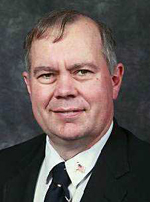
CIPS CONNECTIONS
PODCAST/VIDEO INTERVIEWS by STEPHEN IBARAKIA Chat with Professor Emmett Redd, Physics, Astronomy and Material Science Dept., Missouri State University about his work with super-Turing computation
This week, Stephen Ibaraki has an exclusive interview with Professor Emmett Redd.
 Professor Emmett Redd is finishing his thirty-first year at Missouri State University in the Physics, Astronomy, and Materials Science department. His experience is varied: experimental ion-atom scattering, industrial laboratory automation, microcontroller device development, tornado chasing, and mixed- (digital-, analog-, optical-) signal artificial neural networks. A. Steven Younger, Hava Siegelmann, and Tayo Obafemi-Ajayi are colleagues in the latter effort which includes pursuing super-Turing computation.
Professor Emmett Redd is finishing his thirty-first year at Missouri State University in the Physics, Astronomy, and Materials Science department. His experience is varied: experimental ion-atom scattering, industrial laboratory automation, microcontroller device development, tornado chasing, and mixed- (digital-, analog-, optical-) signal artificial neural networks. A. Steven Younger, Hava Siegelmann, and Tayo Obafemi-Ajayi are colleagues in the latter effort which includes pursuing super-Turing computation.
Current work is centered on modeling and using stochastic resonance to enable super-Turing computation and to move artificial neural networks closer to true universal approximation. The only available method for demonstrating super-Turing computation is mimicking chaos. With a mixed- (analog-optical and digital-electronic) signal system, Younger and I have demonstrated that it mimics the logistic map. However, mimicking chaos does not provide a method of showing practical benefits from super-Turing computation. We hope other researchers can help find a test which shows the practical benefits of super-Turing computation. In the meantime, we are exploring how rigorously we must follow the assumptions of the super-Turing theorems.
Redd has a wife of 42 years, two children, four grandchildren, and a small herd of purebred Charolais cattle.
TO WATCH THE VIDEO INTERVIEW, CLICK ON THIS MP4 file link